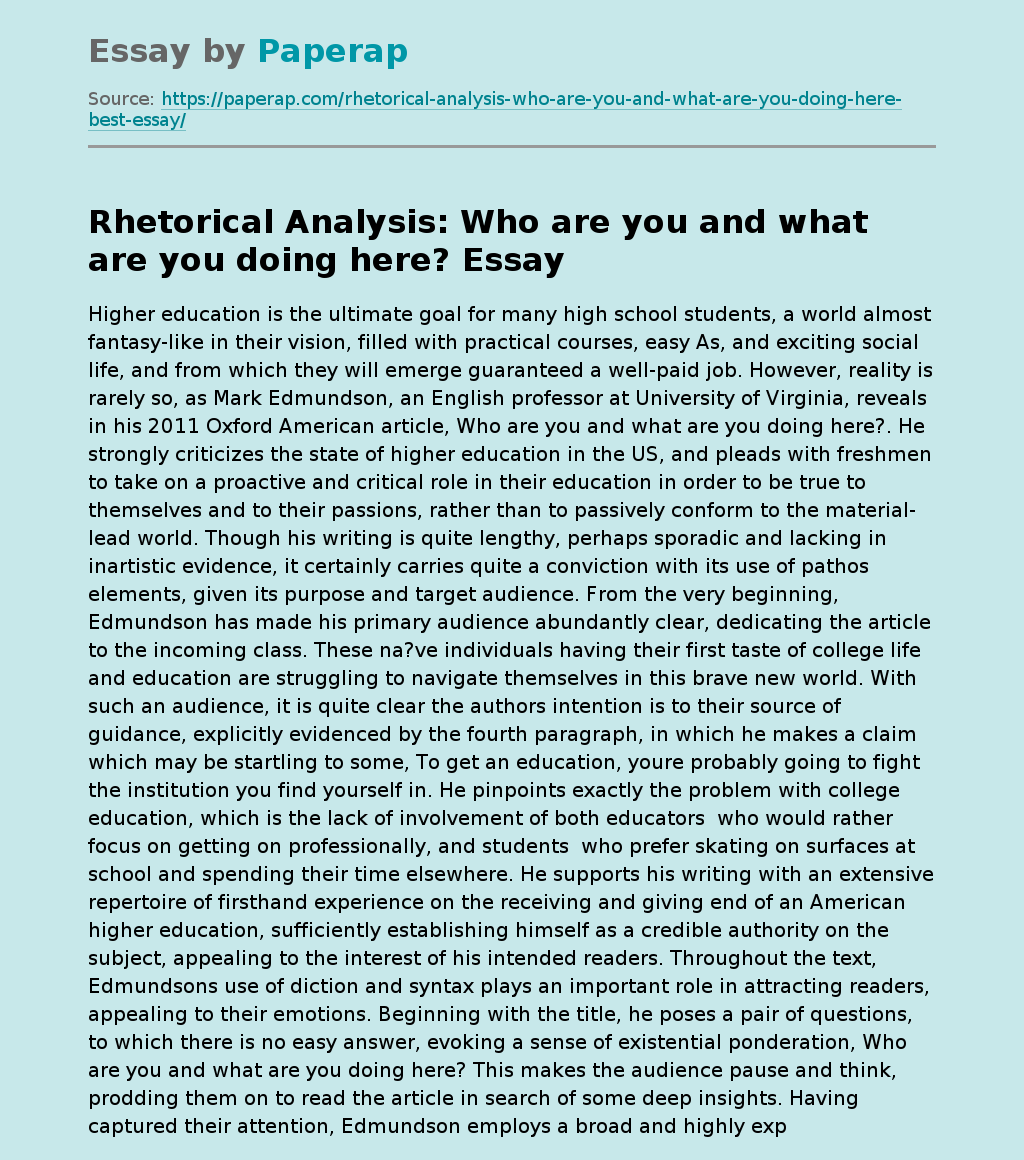Rhetorical Analysis: Who are you and what are you doing here?
Higher education is the ultimate goal for many high school students, a world almost fantasy-like in their vision, filled with practical courses, easy As, and exciting social life, and from which they will emerge guaranteed a well-paid job. However, reality is rarely so, as Mark Edmundson, an English professor at University of Virginia, reveals in his 2011 Oxford American article, Who are you and what are you doing here?. He strongly criticizes the state of higher education in the US, and pleads with freshmen to take on a proactive and critical role in their education in order to be true to themselves and to their passions, rather than to passively conform to the material-lead world.
Though his writing is quite lengthy, perhaps sporadic and lacking in inartistic evidence, it certainly carries quite a conviction with its use of pathos elements, given its purpose and target audience. From the very beginning, Edmundson has made his primary audience abundantly clear, dedicating the article to the incoming class.
These na?ve individuals having their first taste of college life and education are struggling to navigate themselves in this brave new world. With such an audience, it is quite clear the authors intention is to their source of guidance, explicitly evidenced by the fourth paragraph, in which he makes a claim which may be startling to some, To get an education, youre probably going to fight the institution you find yourself in. He pinpoints exactly the problem with college education, which is the lack of involvement of both educators who would rather focus on getting on professionally, and students who prefer skating on surfaces at school and spending their time elsewhere.
He supports his writing with an extensive repertoire of firsthand experience on the receiving and giving end of an American higher education, sufficiently establishing himself as a credible authority on the subject, appealing to the interest of his intended readers. Throughout the text, Edmundsons use of diction and syntax plays an important role in attracting readers, appealing to their emotions. Beginning with the title, he poses a pair of questions, to which there is no easy answer, evoking a sense of existential ponderation, Who are you and what are you doing here? This makes the audience pause and think, prodding them on to read the article in search of some deep insights. Having captured their attention, Edmundson employs a broad and highly expressive vocabulary to convey his message. He describes the lives of students as a luxury reserved for celebrities, warns them of graduating as servants at some dead-end jobs, and repetitively uses the phrase life is elsewhere. In doing so, he paints a grim picture of college in vivid details, marked by a mind-numbing zeitgeist. On the contrary, when suggesting a solution, he tells freshmen to fight, to struggle and strive, and to be aggressive and assertive, all of which have a strong connotation. They successfully elicit in readers a fierce opposition to the dull reality of college, an effervescent desire for a real education, and maybe encourage them to spring into actions. The tone and style which Edmundson adopts also greatly assist in engaging the audience. As he proceeds with the article, he remains consistent in his laid-back and humor-laced tone, thus closing the gap between readers and author. He uses casual and informal metaphors to describe an incident in which he was threatened by a student. He characterizes it as the samurai-kid episode, calling it small potatoes in comparisons with other on-campus incidents. This effectively cuts down on the rather heavy and serious nature of what is being said, keeping the conversation light-hearted and interesting to readers. Edmundson also uses a story-telling approach in his writing. His arguments are not organized in any logical order. Instead, he appears to write following his own train of thoughts without any filter, seemingly reciting any random stories that might come to his mind at any given time, further endearing him to his audience. They do not feel like they are reading an article written by a highly apt and shrewd professor. Rather, to them, it is simply listening to an old friend, creating a sense of intimacy and trust. As efficacious as his appeal to pathos is, Edmundson seems to slack off in logos elements. His article risks being seen as biased when it fails to back its claims with impersonal, inartistic proof. All of Edmundsons arguments are solely based either on his past experience or his subjective observations, not on scientific studies or academic research. They might not be invalid, however, they may take away from the articles overall objectivity and credence. Additionally, his unorganized arguments, though sincere, makes it difficult to follow his logic, which may be displeasing to some readers, or may prove to be ineffective in convincing them of his views. He has a tendency of straying from the central argument. For example, a considerable part of the article is spared for his analysis of the works of Sigmund Freud and Ralph Waldo. Though interesting, it is completely irrelevant to the matter at hand. By way of conclusion, it is my opinion that Edmundson has succeeded in achieving his purpose in this particular article, despite the lack of appeal to logos. His carefully chosen phrases and the endearing nature of the article are a perfect match for the targeted audience of college freshmen, who are probably already overwhelmed with the new university. Edmundson has well avoided the feeling of another dull seminar, giving his article a resemblance to an inspiring pep talk imbued with personal stories, casual wording and deep insights.
Rhetorical Analysis: Who are you and what are you doing here?. (2019, Dec 10). Retrieved from https://paperap.com/rhetorical-analysis-who-are-you-and-what-are-you-doing-here-best-essay/

